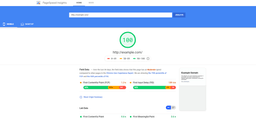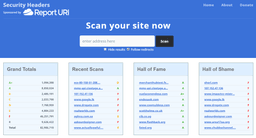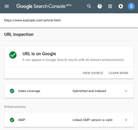
One of the most important but often overlooked tasks within SEO is a website migration. If done well, a good migration has the ability to propel your site’s visibility forward. But if overlooked or done poorly, can put you out of business. One size does not fit all, but this post outlines a solid process to follow that will help ensure your SEO friendly website migration goes smoothly.
What is a website migration?: Types of Website Migration
There are many different scenarios that can be categorised as a migration. However, it’s important to apply the same protocol to all scenarios where there are significant changes that may impact organic search presence.
HTTP to HTTPs Migration (Secure to Non-Secure)
Moving to HTTPS protocol is something that has gone wrong for many sites in the past, as Google made an announcement on the 8th of February 2018 stating that Chrome would mark sites using HTTP as ‘not secure’ and place a warning page stating that before a user can enter the site. This prompted a surge in sites moving to HTTPS and as such there were lots of cases of site losing significant amounts of organic traffic by not being pragmatic in how this process was executed.
Moving from one URL to another (Domain Migration)
Moving from one site to another means moving a site or changing its structure from one URL to another. Whether that be the sub-domain (www) or the domain name (flauntdigital) or the top-level domain (.com).
Sub-domain or sub-folder
Sub-domain or sub-folder changes often occur when a site wants to move to have an international presence. Creating a site on country-specific sub-domains or sub-folders such as:
- mysite.com
- UK.mysite.com
- FR.mysite.com
- ES.mysite.com
OR
- Mysite.com
- mysite.com/UK
- mysite.com/FR
- mysite.com/ES
This change requires a full migration plan as well as the planning and execution of Hreflang . Hreflang is the protocol for marking the international versions of a site up to inform search engines which site to index in which country. If this is done incorrectly or not done at all, you risk presenting Google with thousands of pages of duplicate content and you will likely be heavily penalised.
Site structure changes
This is a common occurrence and is something that be accidentally done without thought. Structural site changes are when the information architecture of a site or the navigation or internal links are changed. These changes might make sense on the face of it, but taking the time to have wider consideration for the impact those changes will have on the organic search presence is essential. For example, if you have a URL that is:
- mysite.com/womens/dresses/spring-summer
Then you think I want to order my URL’s by season and change it to:
- mysite.com/spring-summer/womens/dresses
Because this is an easy thing to implement you may not give it much thought beforehand or after doing it, but, this change means search engines will now not find the original URL, therefore, losing any existing rankings that that page has.
Replatforming
Replatforming happens a lot, a site may naturally outgrow its current CMS or platforms capabilities so you decide to move to something that can service your websites needs more effectively. This is something happens quite often with eCommerce sites, changing from Shopify to Magento, or BigCommerce to WooCommerce is a common conversation we encounter. There are lots of sites currently in the process of upgrading from Magento 1 to Magento 2 as a result of Magento 1 becoming unsupported from June 2020, this can be tricky but if done well can have yield great improvements.
There are also considerations when upgrading a CMS, sometimes moving to the latest version of a platform can include lots of changes to the basic functionality which could impact organic search. Getting ahead of this and making sure vigilant checks are performed on a staging environment is key to getting this right and not damaging your SEO performance.
Content Migrations
Moving a section of content or restructuring content can have a negative impact on the organic search presence of that content. If the changes are going to affect the site’s taxonomy it needs to be considered, looking at things such as where the content is being moved from and to and the internal linking structure of that content.
UX and user journey design
When you have a design team working on a site there are changes to layouts or user journey flows that will be pushed forward, these changes will need to be considered from an organic search perspective to make sure they don’t impact organic search presence. Sometimes simple changes can have a significant impact if not addressed or rolled out properly.
Why do website migrations fail?
Underestimating the impact
One of the main causes for an SEO website migration to fail is underestimating the impact. We’ve worked with clients that have underestimated the impact of a website migration and seen dire consequences. A couple of examples of this would be:
- A large media brand we have worked with performed a website replatform, this was handled very poorly and with inadequate planning, to give an example they only had 60-70% accuracy in their redirects, this error alone resulted in a 40% loss in organic traffic.
- Due to a faceted navigation index leak, a leading fashion client submitted over 3 million URLs of duplicate content to the Google index from their previous 15K resulting in organic traffic loss of 44% in only a matter of weeks.
The commercial impact of the examples given above were significant. Estimating the impact of an SEO website migration is difficult to do so the best way of approaching it is to mitigate the potential risks before they even occur.
Late involvement of SEO considerations
Getting someone expert in SEO or an SEO agency involved with a website migration should happen at the start of the process, right at the planning stage rather than in the middle or after the migration has happened. A scenario we see often is clients and businesses underestimate the impact of a website migration, carry it out, see a drop in organic search performance and THEN look to get the issues corrected. By the time the work has been carried out it is too late, the impact has hit which then turns the work into a recovery mission – which can be a very difficult task.
When do I need to involve SEO in a website migration?
To validate the need to bring in some SEO expertise ask the following simple questions and they should help:
- Does our website currently drive a lot of revenue or leads for the business?
- Is there a risk this plan will affect the above?
- Do we have the experience to execute the plan with confidence to mitigate the risk?
If you answered yes to number one or two, or both then get some advice. If you answer yes to number one or two or both and number three you definitely need to initiate conversations with professionals who can understand the magnitude of the migration task, and also potentially put a plan together for how the migration could accelerate the performance of your website.
SEO Testing Phase
Often when there is a lack of consideration when it comes to changes being made to a website or a migration that will likely mean that there is a lack of testing going on, or even no testing at all. Where possible you should always try to maintain an up to date staging environment to run tests on ahead of pushing changes to the production or live website. Think of a staging site as your safety net, and although your staging site will not be visible in search (it needs to be excluded from search to avoid duplicate content) you can see how things will change in an environment that is as close to the live site as possible.
Think of a staging site as your safety net, and although your staging site will not be visible in search (it needs to be excluded from search to avoid duplicate content) you can see how things will change in an environment that is as close to the live site as possible.
When it comes to a large change or an SEO migration piece it is essential to have a robust testing phase, not putting a testing phase in as part of the process will cause you issues that you can easily mitigate during a testing phase.
How to do an SEO friendly website migration
To perform a successful SEO friendly website migration you need to have a plan, without a plan you cant keep track of what needs to be done and tick things off as they are completed. There are differences in every example of an SEO website migration and there will be unique things you may have as part of your online operation that you need to consider. The remainder of this post is designed to give you a comprehensive list of checks and protocols to carry out, in the order in which they should ideally be done.
Pre-migration
First of all, it is important to define the goal of the migration. Why are you looking to do it, are you looking to improve the structure of your website? Are you moving from HTTP to HTTPS? Are you re-platforming to a new CMS?
Is this a strategic move to allow for organic performance growth or are you looking to clear up some legacy issues?
These are the kind of questions that need to be answered at the start of the process so you can best plan to achieve the purpose of the migration project. Once you have set that out you will need to begin running the tasks and checks as part of the pre-migration phase. It’s important to weigh up the risks.
Full existing website crawl
The first step is to perform a full website crawl to get a full picture of your existing website. Use a tool such as Screaming Frog’s crawler to do this and make sure you run the crawl using Screaming Frog’s user agent and Google’s smartphone user agent.
Cross-check the two crawls to make sure they produce the same results. Google’s is now mobile-first when it comes to crawling your website to it’s vigilant to get the same view of your site as Google is getting.
Target (staging) website crawl
Now we need to run a crawl of the staging environment to cross-check this with the existing site, this will help identify any differences between the current and new website. As with the existing website crawl, be sure to run the crawl using the two user agents as before to keep the crawls consistent.
Batch site speed analysis
Getting site speed right is more important than ever with Google making huge efforts to give fast sites more coverage in search, especially in the mobile results. This is a good opportunity to make any improvements to your websites speed but also you don’t want to go backwards.
At Flaunt Digital, we use some proprietary technology along with Google Lighthouse testing tool to run speed analysis of a full website, this give a great overview of the performance of each section of the site and allows us to pinpoint optimisations in different areas.
If you can’t run site speed testing at scale split out your site into page types and run tests on as many as you can using Google’s Page Speed Insights tool. But remember, this only gives a result for the page you scan, not your whole website? Are there any less obvious but key pages slowing your site down?
Run a test on your home page and then as many other types of pages as you can:
- Mywebsite.com
- /contact-us
- /category-page
- /category-page/sub-caregory
- /blog-page
Running speed checks across multiple different pages will give you the best view of your true site speed and help identify any differences across the different areas of your site.
Backlink crawl
Testing the backlink profile during an SEO migration is sometimes overlooked but is a must! Links are hard to earn so you need to make sure you are protecting them during the move. Use a tool such as ahrefs, moz or majestic SEO or all three if you can to get a list of your backlinks. Once you have a list of destinations your links are pointing to you can change your website URL to the staging environment URL and upload them to Screaming Frog to see if any return error codes.
Compile a 301 redirect map
We recently saw a client only have 60-70% confidence in the accuracy of their redirects and as a result, the lost 40% of their organic traffic. Compiling and implementing a comprehensive 301 redirect map is key to the success of an SEO friendly website migration.
A 301 redirect is a permanent redirect and so is treated as such by search engines meaning that your inherent authority will be passed from the old site to the new. You need to make sure you have got a canonical URL structure in place for the new site which is the final URL you will use when creating the 301 redirect rules.
When mapping URL’s, the goal is to map them to the most relevant page on the new site, this ensures you maintain relevance and also a good user experience which search engines favour. If you have a page from your old site that no longer exists or doesn’t have a like for like on the new site decide if there is an area of the site that is best suited and failing that redirect it into the home page.
Use your full crawl from Screaming Frog to compile a spreadsheet consisting of all the existing sites URL’s and the new destination URL. You will then need to work with your developer to understand the server set up and how it handles redirects.
Make sure when you are putting together the redirect map you don’t cause any potential duplicate content risks by not using the canonical versions of the new sites URLS. For example dont:
- Don’t use uppercase letters (/Example-Url)
- Don’t use non-https URL’s
- Don’t use trailing slash URL’s if your canonical version is non-trailing slash and vice versa
Header security
Header security is very important, especially customers can pay for goods through your website. Testing that any HTTP or non-www versions of your domain redirect to HTTPS is essential from a security standpoint.
You should also employ the HSTS (HTTP Strict-Transport-Security) protocol which ensures that your site cannot be accessed without using a HTTPS protocol. This is supported by all major browsers, this blog post by Mozilla describes how to implement it and the benefits of doing so. You should have your site set up to only use HTTPS by default using redirects, then look to implement HSTS.
You can also check your header security at the aptly named, securityheaders.com. Here you’ll get a breakdown of your potential security issues and links to guides on how to fix and address each one.
Faceted navigation checks (mainly e-commerce)
Using the crawl data you have from the two Screaming Frog crawls you should have run by now, check the faceted navigation to make sure you have everything locked down with nofollow links and the right canonical tag structure.
If you have an infinite loop of faceted filter options a crawler will get stuck in an infinite loop trying to crawl all these URL’s. This is known as an index leak and can take priority away from your ranking pages when it comes to crawlers assessing your site which will hinder the ranking progress of your key landing and category pages.
This is what happened when a fashion client we now work with executed a website migration that lead to over 3,000,000 URLs from their faceted navigation be crawled by Google. They lost 44% of organic traffic within weeks due to mass amounts of duplicate content.
Robots.txt file creation
Make sure you create and test a robots.txt file for the new site, this needs to shape how you want your site to be crawled and what you would like to be indexed, as well as what you would not. Don’t rush this, if you carry across am incomplete robots.txt file it can be a disaster, take the time to make sure it is correct and run checks on any rules within the file to make sure it is behaving correctly.
XML sitemap
Make sure that you have an up to date XML sitemap in place before the migration, use the crawl data and analytics data to make sure there are no orphan pages in the sitemap. Check that all the pages you want to be crawled are present, if your site is a large site you may have multiple sitemaps so make sure you don’t overlook any.
Benchmarking
Making sure you have a view of your websites organic performance and ranking efficacy ahead of pushing any migration changes out is the best way quickly understand if your migration has been a success or if something has gone wrong. Not creating some benchmark reports before an SEO migration will just make the post-migration work more difficult and less reliable, hindering any quick fixes you might need to reactively put in place.
Keyword ranking report
If you are not already tracking keywords against your website then I suggest using a tool such as SearchMetrics to get a view of the keywords your website is ranking for. We use Accuranker to track clients keywords on a daily basis and would pull down a full ranking report for all keywords prior to executing redirects etc. Similarly to running a crawl of the website for both desktop and mobile you need to do the same with your keyword benchmark reports, this report will help you quickly identify improvements or negative fluctuations following the migration.
It’s not recommended to rely on the recently increased, but still limited, data that Google Search Console gives you – but even this is better than nothing.
Page titles and meta descriptions
Page titles still have a good impact on a pages ranking relevancy so making sure that you carry over the page titles from your existing site is essential. If you don’t have optimised title tags in place on your existing site use this an opportunity to go through them and optimise them – having these optimisations in place ahead of the migration will help towards increasing landing page relevancy and you may see ranking performance increases if optimised well.
With the meta descriptions, the same applies as title tags, make sure you have them in place on all pages whether that means through the CMS or not. Although they are not a ranking signal meta descriptions still present a great opportunity to increase click-through rates. If you haven’t given them much thought or optimised them to this point do it ahead of the migration.
Migrating your tracking
Tracking and analytics are really important for analysing site performance, user engagement and revenue or lead volumes. Making sure you move across all your tracking is something that can easily be done but sometimes gets forgotten or not carried out properly.
Move your tracking codes into the staging environment and test that they are tracking as expected, make sure you also test any custom events or tracking customisations are in place too. If you have an eCommerce site put a test transaction through to make sure your sales and revenue are being tracked and recorded properly.
You will also need to make sure that you verify Google Search Console to track the new site, if you use the HTML snippet to do this make sure you move this across to the new site. You will be utilising some of Search Console’s features post-migration so it’s important to have it set up.
Go live: Post-Migration
By now you have been through a lot of checks and tests to make sure you are going to have a seamless experience when it comes to the migration. You should have checked the following off your list:
- Full existing website crawl
- Target (staging) website crawl
- Batch site speed analysis
- Backlink crawl
- Compile a 301 redirect map
- Header security
- Faceted navigation checks (mainly eCommerce)
- Robots.txt file creation
- XML sitemap
- Keyword ranking report
- Page titles and meta descriptions
- Tracking migration
You should now be in a really good position to go-live and schedule a time with your development team to execute the redirects as the rollout is happening.
Post-migration checklist
Now that you have pulled the trigger and put all your hard work into practice you should now see the site redirecting working.
Have a look through the site and make sure it is operating how you would expect and that there are no major issues that you can see right away. Once you feel comfortable there are no initial issues you can begin with the post-migration checks.
URL inspection from Google Search Console
Head over to search console and test some live URL’s using the URL inspection tool, you should get a green tick next to the following things:
- URL is on Google
- Coverage (and if the URL is present in the sitemap)
- Mobile usability – whether your page is mobile-friendly or not
If you test and get green ticks you are good to move along to the next test.
Test your tracking
Make sure all the tracking you migrated is now tracking live traffic, Google Analytics realtime view is a quick way to make sure this is all working.
If you don’t see anything in the realtime panel, refresh your site and click around a bit whilst watching the realtime panel. If you still see nothing it is likely that you have not properly migrated the tracking code. Go check and see if your tracking code is present and correct if it is then you need to do some further digging as to why you are not seeing traffic coming through.
You can also go into the tracking settings of Google Analytics and request tracking test data to be sent through. This might be useful if you’re going live during a time when you may not naturally receive any visitors.
If you operate an eCommerce site is vigilant to put a test transaction through to make sure this is all set up correctly and tracking through your analytics platform.
Run a full website crawl
As you did in the pre-migration phase, you should now run a full crawl of the live site using both Screaming Frogs user agent and the Googlebot Smartphone user agent. This will allow you to really easily pick up on any issues such as 404 errors or if your title tags are all correct.
Test your 301 redirects
Use the full website crawl to make sure that all your 301 redirects are working correctly, look out for any 404 errors and also make sure there are no other out of place error codes.
Annotate Google Analytics
Put a note in Google Analytics using their annotation feature, this will help you keep track of when the migration happened so you can run analysis better should you see any negative effects to traffic.
Backlink check
Re-run the same backlink check as in the pre-migration work to make sure that all backlinks are pointing to the most relevant page of the new site. Also, where possible try to reach out where you can and have backlinks updated so they are not being forces through a redirect – this is not essential but good practice.
Keyword ranking report
To give you a good view of the progress of your websites organic search presence, run daily keyword ranking reports for the week following the migration. This will help you keep on top of any fluctuations or drops, cross-compare them with the pre-migration reports and make sure that the ranking URL’s are the most relevant if they were redirected as part of the migration.
Summary
Carrying out an SEO friendly website migration is not a one size fits all, there are different requirements and situations that occur based on the set up of a website but the process outlined will get you a long way.
Don’t underestimate the magnitude of moving a site or a re-platform when it comes to organic search presence, even if the move is a small section of content it needs to be done with the thought in mind of mitigating as much risk of traffic and organic coverage loss as possible.
Need help with a migration? We can help! Get in touch here.
Have a question on how to do an SEO friendly website migration? Why not drop a comment below or let us know on Twitter or Instagram?














